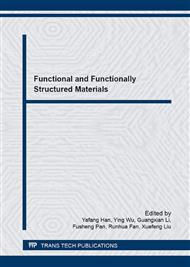[1]
Aurivillius B. Mixed bismuth oxides with layer lattices. 1. The structure type of CaNb2Bi2O9, J. Arkiv for kemi. 1(5) (1950) 463-480.
Google Scholar
[2]
Newnham R E, Wolfe R W, Dorrian J F. Structural basis of ferroelectricity in bismuth titanate family, J. Materials Research Bulletin. 6(10) (1971) 1029-1039.
DOI: 10.1016/0025-5408(71)90082-1
Google Scholar
[3]
Frit B, Mercurio J P. The crystal chemistry and dielectric properties of the Aurivillius family of complex bismuth oxides with perovskite-like layered structures, J. Journal of alloys and compounds. 188 (1992) 27-35.
DOI: 10.1016/0925-8388(92)90639-q
Google Scholar
[4]
Chen Xiaochen. Spontaneous polarization bonds model of ferroelectrics—Calculation of spontaneous polarization Ps of perovskite, tungsten bronze ferroelectrics, J. Chinese Science Bulletin. 3 (1982) 153-155.
Google Scholar
[5]
King-Smith R D, Vanderbilt D. Theory of polarization of crystalline solids, J. Physical Review B. 47(3) (1993) 1651-1654.
DOI: 10.1103/physrevb.47.1651
Google Scholar
[6]
Resta R, Posternak M, Baldereschi A. Towards a quantum theory of polarization in ferroelectrics: The case of KNbO3, J. Physical review letters. 70(7) (1993) 1010-1013.
DOI: 10.1103/physrevlett.70.1010
Google Scholar
[7]
Shimakawa Y, Kubo Y, Nakagawa Y, S. Goto, T. Kamiyama, H. Asano, F. Izumi. Crystal structure and ferroelectric properties of ABi2Ta2O9 (A= Ca, Sr, and Ba), J. Physical Review B. 61(10) (2000) 6559-6564.
Google Scholar
[8]
Hervoches C H, Snedden A, Riggs R, Kilcoyne S H, Manuel P, LightfootI P. Structural Behavior of the Four-Layer Aurivillius-Phase Ferroelectrics SrBi4Ti4O15 and Bi5Ti3FeO15, J. Journal of Solid State Chemistry. 164(2) (2002) 280-291.
DOI: 10.1006/jssc.2001.9473
Google Scholar
[9]
Stachiotti M G, Rodriguez C O, Ambrosch-Draxl C. First-principles investigation of SrBi2Ta2O9, J. Ferroelectrics. 237(1) (2000) 49-56.
DOI: 10.1080/00150190008216231
Google Scholar
[10]
Ke H, Wang W, Zheng Z X, Tang C L. First-principles study of spontaneous polarization in SrBi2Ta2O9, J. Journal of Physics: Condensed Matter. 23(1) (2011) 015901.
Google Scholar
[11]
Phillips J C, Van Vechten J A. Dielectric classification of crystal structures, ionization potentials, and band structures, J. Physical Review Letters. 22(14) (1969) 705-708.
DOI: 10.1103/physrevlett.22.705
Google Scholar
[12]
Phillips J C, Van Vechten J A. Nonlinear optical susceptibilities of covalent crystals, J. Physical Review. 183(3) (1969) 709-711.
DOI: 10.1103/physrev.183.709
Google Scholar
[13]
Phillips J C, Van Vechten J A. Charge redistribution and piezoelectric constants, J. Physical Review Letters. 23(19) (1969) 1115-1117.
DOI: 10.1103/physrevlett.23.1115
Google Scholar
[14]
Van Vechten J A. Quantum dielectric theory of electronegativity in covalent systems. I. Electronic dielectric constant, J. Physical Review. 182(3) (1969) 891-905.
DOI: 10.1103/physrev.182.891
Google Scholar
[15]
Phillips J C. Ionicity of the chemical bond in crystals, J. Reviews of Modern Physics. 42(3) (1970) 317-356.
DOI: 10.1103/revmodphys.42.317
Google Scholar
[16]
Levine B F. d-Electron effects on bond susceptibilities and ionicities, J. Physical Review B. 7(6) (1973) 2591-2600.
Google Scholar
[17]
Levine B F. Bond susceptibilities and ionicities in complex crystal structures, J. The Journal of Chemical Physics. 59(3) (1973) 1463-1486.
DOI: 10.1063/1.1680204
Google Scholar
[18]
Zhang S Y. Investigation of chemical bonds on complex crystals, J. Chinese Journal of chemical physics. 4(2) (1991) 109-115.
Google Scholar
[19]
Gao F, He J, Wu E, et al. Hardness of covalent crystals, J. Physical review letters. 91(1) (2003) 015502.
Google Scholar
[20]
Gao Faming, Gao Lihua. Dielectric theory of chemical bond in crystals and its application, J. Journal of YanShan University. 35(3) (2011) 189-197.
Google Scholar
[21]
Zhang Siyuan, Xue Dongfeng. Chemical Bonds of complex structure crystals and nonlinear optical effect, J. Journal of Graduate School, Academia Sinica. 17(1) (2000) 36-42.
Google Scholar
[22]
Gao L, Gao F. Chemical bond properties and hardness estimation of rare earth garnets, J. Materials Chemistry and Physics. 113(1) (2009) 145-149.
DOI: 10.1016/j.matchemphys.2008.07.069
Google Scholar
[23]
LI S C. AEC: A New Tool for EET, TFDC and Crystal Formula[C]. Materials Science Forum. 689 (2011) 245-254.
DOI: 10.4028/www.scientific.net/msf.689.245
Google Scholar
[24]
Shimakawa Y, Kubo Y, Nakagawa Y, et al. Crystal structures and ferroelectric properties of SrBi2Ta2O9 and Sr0. 8Bi2. 2Ta2O9, J. Applied physics letters. 74(13) (1999)1904-(1906).
DOI: 10.1063/1.123708
Google Scholar
[25]
Brown I D, Altermatt D. Bond-valence parameters obtained from a systematic analysis of the inorganic crystal structure database, J. Acta Crystallographica Section B: Structural Science. 41(4) (1985) 244-247.
DOI: 10.1107/s0108768185002063
Google Scholar
[26]
Amorín H, Bdikin I K, Kholkin A L, et al. Growth and characterization of ferroelectric SrBi2Ta2O9 single crystals via high-temperature self-flux solution method, J. Physics of the Solid State. 48(3) (2006) 537-543.
DOI: 10.1134/s1063783406030206
Google Scholar
[27]
Rae A D, Thompson J G, Withers R L. Structure refinement of commensurately modulated bismuth strontium tantalate, Bi2SrTa2O9, J. Acta Crystallographica Section B: Structural Science. 48(4) (1992) 418-428.
DOI: 10.1107/s0108768192001654
Google Scholar
[28]
Irie H, Miyayama M, Kudo T. Structure dependence of ferroelectric properties of bismuth layer-structured ferroelectric single crystals, J. Journal of Applied Physics. 90(8) (2001) 4089-4094.
DOI: 10.1063/1.1389476
Google Scholar
[29]
Irie H, Miyayama M. Dielectric and ferroelectric properties of SrBi4Ti4O15 single crystals, J. Applied Physics Letters. 79(2) (2001) 251-253.
DOI: 10.1063/1.1384480
Google Scholar


